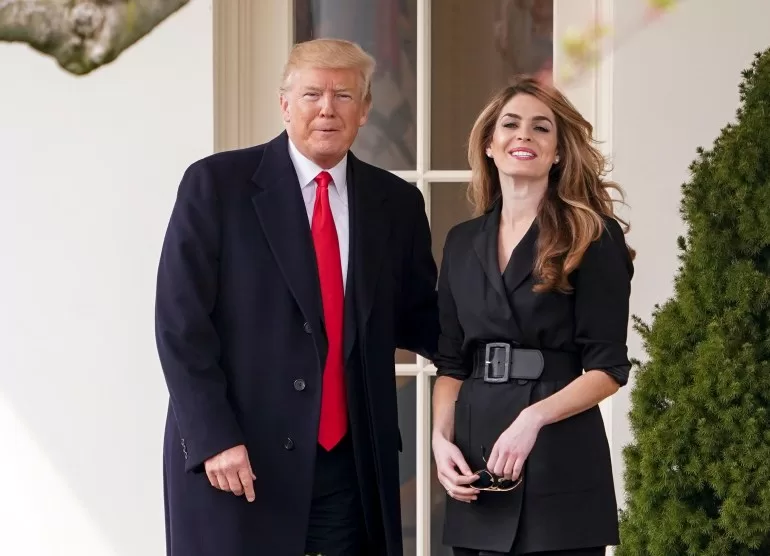Friday marked day 11 in the trial, and Hicks was arguably the highest-profile witness to testify so far.
A former model-turned-communications director, Hicks was one of Trump’s longest-serving aides, helping his 2016 presidential campaign navigate the scandals at the heart of the New York criminal case.
Trump stands accused of 34 felony counts of falsifying business records at the time of the 2016 race, related to hush money payments made to the adult film star Stormy Daniels.
Daniels had claimed she and Trump had an affair, and prosecutors have argued Trump tried to buy her silence as a means of influencing the election. He was already under scrutiny at the time for statements made on tape about his interactions with women.
Trump has denied the extramarital affair, and he has insisted he committed no wrongdoing. His defence team has argued that Trump simply hoped to spare his family embarrassment – not interfere with the election.
The New York trial is one of four criminal cases Trump faces as he runs for reelection this November. Here are five takeaways from Friday’s hearings:
Yes, Trump is allowed to testify
The day’s legal drama began even before Trump entered the courtroom, as the former president sought to backtrack on comments he had made the evening before.
On Thursday, Trump had falsely told reporters, “I’m not allowed to testify.”
“This judge is totally conflicted, has me under an unconstitutional gag order,” Trump continued. “Nobody’s ever had that before. And we don’t like it.”
But as he returned to court on Friday, Trump attempted to clarify his earlier statement: “The gag order is not to testify. The gag order stops me from talking about people and responding when they say things about me.”
Thursday’s comments, however, remained Judge Juan Merchan’s first order of business as he took the bench.
“The order restricting extrajudicial statements does not prevent you from testifying in any way,” Merchan said on Friday.
Witnesses testify from district attorney’s office
As testimony continued, the first two witnesses of the day spoke to the technical aspects of the case.
Returning from Thursday was forensic analyst Douglas Daus, from the Manhattan District Attorney’s Office. He had previously shared evidence that was retrieved from the phone of Trump’s former lawyer, Michael Cohen, including secret recordings.
Emil Bove, from Trump’s defence team, attempted to get Daus to admit to “gaps in the handling of this data” by pointing out that the events in question happened in 2016 – and Daus received the phone to examine in 2023.
Then, another witness from the district attorney’s office took the stand: paralegal Georgia Longstreet. She spoke to evidence gathered from Trump’s social media accounts, including a post from 2016 complaining about levels of support from women voters.
Hope Hicks takes the witness stand
The third witness of the day was the most anticipated: Hicks, a former member of Trump’s inner circle.
At age 26, after working for Trump’s daughter Ivanka, Hicks was handpicked to be his press secretary as he launched his 2016 presidential bid.
Prosecutors subpoenaed her to testify about the inner workings of the campaign and the Trump Organization.
Hicks testified she thought Trump “might be joking” by naming her his press secretary. But she explained she was quickly on the road to states like Iowa, on the campaign trail with the then-candidate.
She explained that Trump was very involved in the day-to-day media strategy of his campaign.
“I would say that Mr Trump was responsible,” she said of his authority over press relations. “He knew what he wanted to say and how he wanted to say it, and we were all just following his lead.”
Hicks reflects on Access Hollywood tape
Much of her testimony, however, revolved around an audio recording known as the Access Hollywood tape, which captured Trump bragging about “grabbing” women by the genitalia.
Hicks explained she first became aware of the recording when a Washington Post reporter emailed her a transcript.
“I was concerned, very concerned,” she said, testifying that she encouraged the campaign to “deny, deny, deny”.
The tape became public in October 2016, one month before that year’s presidential election. In the aftermath, Hicks said Trump was concerned about how his wife Melania would react.
“I don’t think he wanted anyone in his family to be hurt or embarrassed by anything happening in the campaign,” she told the court.
Hicks also spoke about how she became aware of allegations Trump had an affair with Daniels and Playboy model Karen McDougal.
Daniels, she said, briefly came up in conversation at a celebrity golf tournament.
She also explained that, in November 2016, the Wall Street Journal reached out about claims of Trump’s extramarital affairs – and the alleged “catch-and-kill” scheme orchestrated to suppress the story in the media.
“He was concerned about how it would be viewed by his wife, and he wanted me to make sure the newspapers weren’t delivered to their residence that morning,” Hicks said.
At one point, she excused herself from the courtroom in tears, forcing a brief pause in the proceedings.
Trump pays gag order fine
Friday was the deadline for Trump to pay a $9,000 fine for nine violations of his gag order, resulting from a ruling earlier in the week.
But the former president discharged his fine on Thursday, with two cashier cheques: one for $2,000 and another for $7,000.
That was not the end of the matter, though. As Friday’s court proceedings wound to a close before the weekend recess, prosecutors petitioned the judge for the ability to question Trump about the gag order violations.
Trump is barred from speaking about jurors, witnesses, court staff and other people involved in the trial in a way that might affect court proceedings.
But Judge Merchan brushed aside the prosecutors’ request, on the basis that it could unfairly bias the jury.
